The autumn months in the garden are almost as busy as early spring. Although the mornings are cool, the afternoons are often quite warm at this time of year, and with the approaching rainy season, this is a perfect time to be planting in the garden.
Ideally, most California native plant species are planted in the fall. Although I’ve picked up a few plants here and there at recent plant sales, I’m actually a little behind on planting the native gardens, but there’s still time.
With three inches of rain in early October, some of the native plant species already in the gardens are going through a second flush of blooms. The Encelia is really starting to put on a show on the slope above the orchard.
Even the native poppies are squeaking out a few fall blooms.
There’s no question though that the star of the fall native garden is still the Epilobium, which is showing few signs of slowing down.
A few non-native blooms are still hanging on too. The Rudbeckias we planted in the repurposed wine barrels are still going strong…
…and the Salvia ‘Mystic Spires’ has filled in tremendously, and is enticing our honey bees to stop and pay a daily visit.
Even the Lavender ‘Provence’ is still producing a few flowers.
Most of the excitement in the garden at the moment though is in the kitchen garden.
Some of the ‘French Breakfast’ radishes planted in September were harvested this weekend, and promptly poached in butter.
The leaves of the ‘Bulls Blood’ beets are turning a vibrant burgundy red.
We appear to be in the midst of a near endless supply of beans, including these Roc d’Or, Maxibel, and Purple Queen.
The Mizuna greens are taking over the garden beds…
…as well as the ‘Mei Qing’ choi…
…and chard.
Hoards of beneficial insects can be found frequenting the blooms from the late summer crops that have now bolted in the garden. There’s a little Arugula in flower at the moment in one bed that’s waiting to be turned over.
Although the Syrphid Flies seem to really prefer the Tatsoi blooms…
…as do the tiny Carpenter Bees.
Although gardening with chickens can be challenging, yesterday the girls helped as the beds of tomatoes and peppers were finally cleared out to make way for some winter greens.
The beds were amended with compost, and the irrigation lines were repositioned, with a little help.
Once the beds were prepared, they were inspected, and given final approval, before the transplants of assorted greens were brought out to be planted for the winter garden.
I spent the rest of the afternoon planting Red Russian and Redbor Kale. Along with Broccoli ‘di Cecco’, and ‘Calabrese’.
Unfortunately, someone else has been nibbling on the broccoli seedlings, but the girls obliged by helping with a little organic ‘pest control’.
These transplants are now housed under floating row covers, but will need to be checked daily for additional caterpillars over the next few days, or the entire crop will look like this.
For some reason they seem to prefer the broccoli over the romanesco, or the cabbages.
Also planted in the greens beds, some beautiful Radicchio…
along with some Romaine lettuces, and Frisee.
New in the garden this fall is a beautiful red Komatsuna. We’ve had some wonderful experiences growing a variety of Asian greens over the summer months, and are excited to see how the Komatsuna does in the garden.
In the herb beds, the lemon Thyme is still going strong. This area at the edge of the garden that we planted in May, to hide the edger board, has filled in tremendously well, and provided a constant source of nectar for the bees throughout the summer months.

As we hoped, the tiny thyme transplants filled in, to conceal the edger board at the top of the slope
The fennel that we allowed to bloom, is mostly done setting seed, although harvesting the seed through the spider webs may prove somewhat challenging.
For some reason, we have a LOT of large spiders in the garden at the moment.
The garden sage is really coming back to life with the cooler weather, and we can’t wait to pair that with our winter squash.
Speaking of squash, we’re still getting an absurd amount of summer squash fruit set, especially from ‘Early Prolific Straight’. Perhaps we should rename it ‘Late Prolific Straight’?

Early Prolific is still living up to its name, and setting a ridiculous amount of fruit for late October
This plant was also responsible for this strange ‘twin’ squash that we discovered in the garden this weekend. Attached to a single stem, this was clearly the product of paired squash blossoms. These squash have grown together, and are connected along almost their entire length.
Our prized Boston Marrow set more fruit after the main harvest was in, and as we haven’t yet pulled all the plants in the squash patch, a few more have ripened.
The very late ‘Greek Sweet Red’ that was just setting fruit when we harvested the rest of the winter squash is actually turning color, so if the bad weather holds off for just a little longer, we may manage to harvest it after all.
The fruits are almost three times the size of our Waltham Butternut, and similar in shape.
While I was inspecting the squash patch, look who I found lurking among the squash blossoms again…
With the winter greens transplanted, the girls will be in charge of keeping an eye on some of them. I almost feel a little mean having planted these ones so close to their ark. I know they’d be willing to taste test them for us!
In the meantime, it’s time for me to head back out to the garden. It’s time to plant garlic, and I have some more native plants to transplant too, but more on those later.
I’m not sure where October went. How can Hallowe’en be just around the corner?


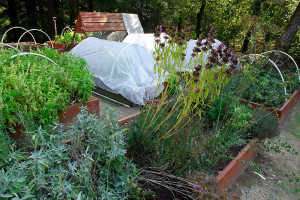
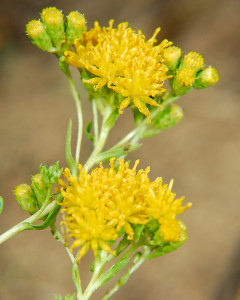

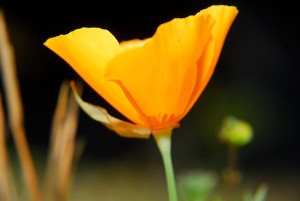

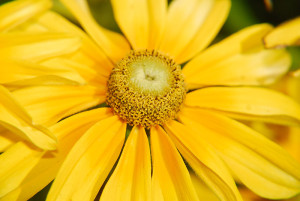
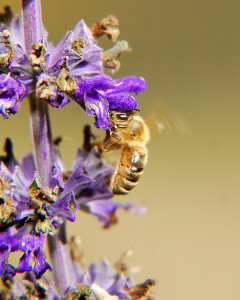

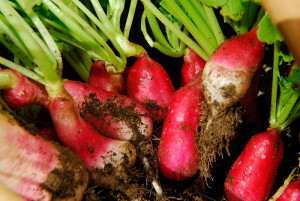

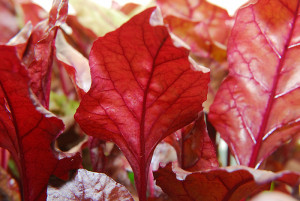



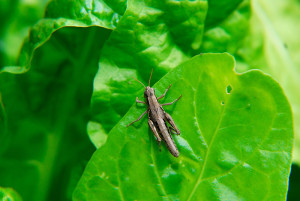




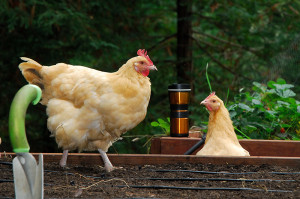

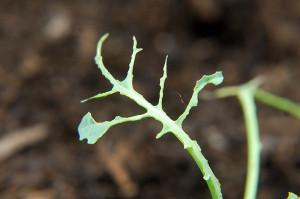
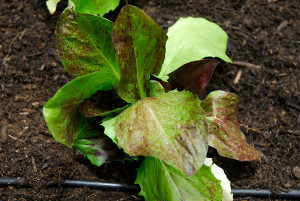
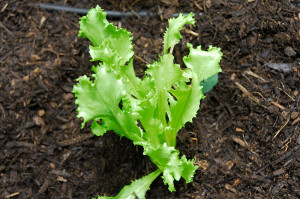
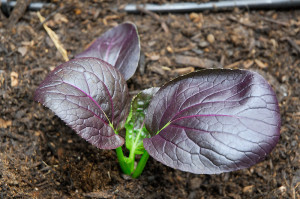

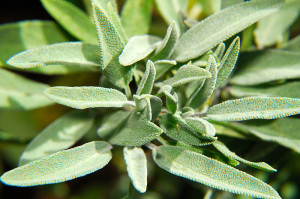
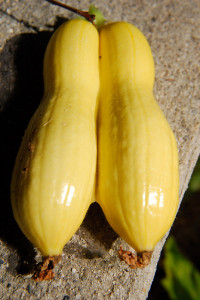
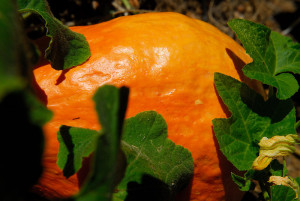
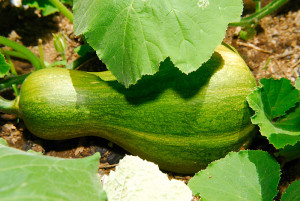
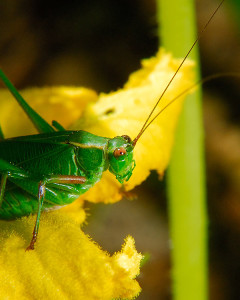
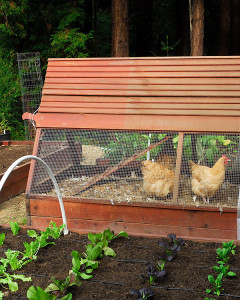
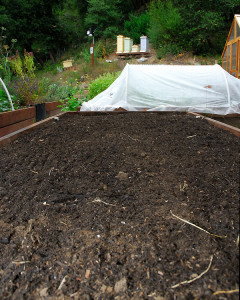







That’s a nice assortment of flowers and edibles you have there! We have some Provence lavender blooming too, sort of a last gasp effort I guess. And I had no idea you could poach radishes! I’ll have to give that a try. I have used them in stir fries for the crunch factor.
Has the greenhouse helped with seedling production? Mine is bursting with them at the moment, waiting for a home.
I didn’t know about poaching radishes either, until I read about it somewhere last year. I specifically planted this variety as they are supposed to be very good poached. Next time I think I’ll add a little tarragon to give them that something extra.
The greenhouse is helping, although it’s not being used to its full potential quite yet. I just had a very large box delivered full of various irrigation pieces and parts. The plan is to set up two zones, one for misting seed trays on a timer schedule throughout the day, and the other for automatically watering plants that are potted up, or recently propagated. Another garden project! 😉
I am envious both of your long season and your large spiders… It’s a greener-grass situation, as I don’t have either of those. But I’ll settle for enjoying your garden from afar. It looks lovely and tidy, which I admire very much.
The garden is a little tidier than it’s been lately, but there’s still work to do! We are fortunate to be able during the late fall and early winter most years. I’m looking forward to some fresh harvests for our Thanksgiving table!
So nice to see that some blooms have reappeared and are providing much needed food for the bees. I like the fancy chicken ark, great way to get your beds turned over and fertilized!
I was surprised at some of the re-bloomers. I may need to rethink where I’ve put the Epilobiums though…purple and red aren’t the best colors to have next to each other 😛
We love the ark. As we made it ourselves, it’s a great fit for any of the fallow raised beds, and girls seem to like it too. Egg production actually went up for them when they moved (they get a little more sun there compared to the other coop).
We have put our gardens to bed for a long winter’s nap. Your garden looks so healthy, well planned, and quite productive. Magazine perfect. I like your inspectors. I am sure that they opinions mean a lot. I have never heard of poaching radishes. How will you serve them? We are expecting our first snow over night. It is supposed to get down to 19 with up to 8 inches of snow. Enjoy your fall!
With the tomatoes out of the way, productivity should increase for a while…at least if the cabbage worms stop mowing down the broccoli 😉
We just served the poached radishes as a regular side dish. Their mild flavor goes well with fish or chicken (they lose that spicy bite when poached). They were poached with butter, a little stock, and some wine vinegar. Some fresh tarragon or a little lemon thyme would probably go well too. I think poached, they’d even be good in a salad, providing they’re not overcooked.
I am so happy to found your blog, and you are located not far from where I live:). I am new to gardening world, lot more to learn, and hoping that I’ll learn tons from your blog. I also want to have chicken coop, but still a bit afraid as my knowledge is so limited at the moment.
Glad you stopped by Dewi! I love your garden, it looks beautiful. It will be fun to compare notes through the season as you’re not too far away.
I think you’d enjoy chickens, and there’s nothing better than fresh eggs. They’re a lot of fun to have around, you just have to keep them away from the newly sprouting vegetables. They can do a lot of damage in a vegetable garden when nobody is looking! 😀
I always see the Komatsuna in salad mixes, but never new what it was called. I even grew some this year in a salad mix I had purchased to put in pots. Now I know!!!! I really think having the chickens in the garden would be such fun, but I guess they get in the way too.
I’m still learning my Asian greens too. After seeing how well the Tatsoi grew here over the last couple of years though, I’m slowly getting more adventurous on my planting, and honestly, I find many of them are more flavorful, and easier to grow, than some of the varieties of spinach.
I love having chickens in the garden, and they’re great for bug control, and compost turning…providing they don’t get too close to the seedlings we’ve just planted (the row covers help though) 😉
Clare, your garden pics look like they should be in a wonderful garden magazine – Even now they are beautiful
Awww…thank you Gloria, you’re too sweet. Your garden is gorgeous too! Maybe I should come clean and take a photo of the piles of plant pots stacked up, and falling over, behind the workshop. That definitely wouldn’t be worthy of being published 😉
I congratulate you, Clare! You are truly multi-talented. Not only are you a wonderful gardener, with fabulous veggies that any produce market would love to sell, but now you have trained your chickens to help out with garden chores! All of your veggies look great. I’m not fond of raw radishes; I will have to try them poached! I have never heard of preparing them that way.
The only trouble with the ‘hired help’ is their union seems to insist they take a break every 10 minutes, and they’re also entitled to sample the product at will 😉 They are fun though, and they do help to clean up stray edibles after the harvest, and recycle the bolted greens too!
you have a lot of harvest, and they are all colorful and looking delicious and healthy. I most especially love the shapes and colors of your squash and radishes. I feel for the chicken, as they can see but cannot eat!
Eventually the chickens get to try the greens they’ve been staring at longingly 😉 They get the thinned seedlings, and any vegetables that bolt, or have been damaged by insects (they like the insects too). They often get a lot of goodies when we turn over the garden beds too.
I am striving for more color in the vegetable garden. It’s one of the things I try to think about more as I’m searching for heirloom seeds to try. Food just looks more exciting when it’s colorful, and it makes the garden more interesting to look at too.
Gosh you still have so much in your garden…well done you. Love your hens…would love to have hens but gave up after the mink devestated our last flock. It was just too heartbreaking.
For all my complaining this summer about our atrociously cold, foggy, and damp weather, we really are fortunate to have such mild fall temperatures here.
I agree, raising hens in the presence of natural predators is very challenging, and heartbreaking when there are losses. After watching a bobcat kill one of our hens last year I questioned the sanity of having chickens here. Our Fort Knox-like day run for the girls definitely helps, but sometimes I long to live somewhere where the girls could just run free. Like your mink, our bobcats and coyotes could wipe out a flock here in less than 24 hours 🙁
I hope you don’t mind my interjection, but I’ve heard of people using watch dogs (common breeds include Great Pyrenees and Newfoundland) to guard their flocks so that they can wander with freedom. I’ve read that they can be very successful in keeping predators at bay from the flocks. Perhaps, you could “hire” a watch dog if you’d like your chickens to roam free. 🙂
Our terrain here is the greatest challenge, and makes it impossible to fence much of an area. We could use invisible underground fencing to keep the dogs in, but it won’t keep the predators out.
We’ve looked into Guardian Livestock Dogs as we’re hoping to add a few dairy goats in the near future. The trouble is that even large dogs like Great Pyrenees may be no match for the Mountain Lions up here. Pen security is still paramount in this part of the mountains, as even tall fences are easily scaled. That said though, the goats probably will find themselves with a resident canine friend living in the barn with them, and while they’re out on pasture, just as an extra layer of security.
Hi Clare,
There’s plenty still happening in your Garden 🙂
I love that you use so many native plants; I wish I had somewhere nearby which sold natives so they were as easy to get hold of. Usually mixes just have the same thing over and over again such as Ox-Eye Daisy, Cornflower, Ragged Robin and blah blah blah but I’d like to locally source them.
I didn’t realize until I was writing this post just how much was going on in our fall garden. The emphasis has shifted. Less flowers and fruit, but a lot more variety of vegetables.
I know seed collecting on public lands here is generally a no-no, but I’m not sure what the rules are anymore in Britain. If you can’t source them locally, what about mail order through a nursery? I think Nickys Nursery in Kent has a fairly extensive selection (of individual seed you can choose, not just those mixes that contain 90% clover or daisy).
Also Landlife Wildflowers looks like they have a reasonable selection of individual species seeds too (6 pages):
http://www.wildflower.org.uk/department/wildflower_seed_single_species/
Although you’re right, everyone seems to stock the obligatory cornflowers and daisies 😉
Clare I love how the girls help in the garden. They are adorable. I cannot get over how much is still growing and especially in your veg garden. You are so lucky to be able to keep going. Everything looks so scrumptious.
I think our old hens have a pretty good retirement plan! Nice quiet country setting, with room and board, delicious views of all the edibles, and first crack at any leftovers! Don’t tell our young hens though, or the turkeys, they’d be jealous if they knew what Babs, Ginger, and Sweet Pea had going on up there in the garden 😛
Love the busy garden assistants 🙂 THanks for your post – the leafy veggies look delicious…oops! Someone already ate them!!
I don’t know why the broccoli was so popular this year 😉 The caterpillars ate more than the chickens!
I can’t believe how many similarities there are in our gardens. Of course, I don’t have chickens, and I didn’t plant as many fall vegetables. But I should have – fall is a much better time for a vegetable garden than spring because it gets so hot so early in the season. I’ve never seen a twin squash, either!
I agree, I enjoy fall planting, especially of greens that can be prone to bolting, much more so than spring planting. I remember this last January we had a whole month of really warm weather, and I kept watching the Tatsoi expecting it to bloom any minute! I didn’t know which seeds to start next. I was going to try a spring spinach crop, but the weather seemed so warm and dry I questioned doing that. Then of course it rained, and rained…right up through June!!! Fall seems more predictable, and the cool mornings much more suited to growing greens here.
Your garden is looking lovely. It is nice to see so many blooms in your garden as mine are slowly waning for fall. The twin squash is so cute…double the flavor. I have been searching for Mizuna greens…now I know what it is called.
Careful with Mizuna. I let some go to seed with the intent of harvesting the seed. I should have bagged the seed heads though, as now we have a mini-Mizuna forest sprouting all over the garden paths! 😉
Your garden is so beautiful, and inspiring. Your chickens are pretty cute and such diligent helpers. I would like to get chickens sometime in the future. Nice veggies too. Here in Lafayette we also had an unusually cold summer. More fog than usual and COLD nights. The only tomatoes that produced a lot were the ones growing along the warm wall that has full sun all day. I think heat reflects off it onto the tomatoes, or something, because they were the only ones performing well. 🙂
The Bay Area weather just seemed chillier than normal in most areas. I think those further inland, around Walnut Creek, or out toward Antioch, had some warmer weather, but a number of gardeners I’ve spoken to noted their gardens were less productive, and much later producing this year. Our vegetable garden is usually in sun all day…but this year it just couldn’t seem to burn through the fog for most of summer. Of course, now the tomato plants are gone, we’ve had blazing sunshine! 😉
Holy Cow – what a garden you have right now! I haven’t tried the Encelia californica ‘El Dorado’ and can’t wait to do so – I love that cheery looking flower!
You have so much life going on around you, dear Clare. I could truly spend a day simply reading all your awesome posts. In awe, you are a dear and truly talented/amazing woman.
Love that twin squash. And I enjoyed seeing your retired hens in their traveling coop. What great helpers. I don’t dare let my three hens out. They’d devour my garden in no time. What they didn’t eat, they’d uproot with their incessant scratching. I harvest my older greens for them, and hand-pick caterpillars for them too. They have me as their servant!
Wow Clare! You have an amazing site and blog. I’m so glad you found my blog through Blotanical. Without Blotanical I would have never found your site! Your farm is pretty much everything I hope to have some day. A garden…chickens…bees. Everything in your farm is very impressive, and even this post was enough to blow me away! If you don’t mind, I will be adding your site to my blog role for sure!